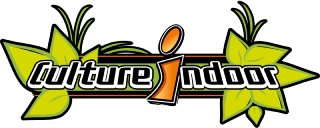THE GROWTH
After the germination of the seedling (plant resulting from a seed), a plant enters in growth or vegetative phase as soon as its second stage of leaves is constituted after the cotyledons (the first two leaves).
Within the framework of the cutting, the growth starts after the appearance of the roots. In general, the vegetative phase is carried out under 18 hours of light and 6 hours of night, both without interruption. During this period, the temperature in thegrowing space during this period, the temperature in the room must be contained between 20 and 25°C and the hygrometry between 50 and 70%.
 In ground:
In ground:
Especially indoors where the space intended for the culture is limited, it is recommended to make "root concentration".
The root system being greedy, the first two or three weeks of growth, it is preferable to make evolve seedlings or cuttings in small pots (0,75L to 1,3L). As soon as the roots are visible or come out at the bottom of the pot, it is time to repot or transplant the plants in an intermediate pot (3 to 5 L) taking care to add a thin layer of clay balls in the bottom to prevent any risk of mould (do not leave the soil permanently in contact with the water collected by the underside of the pots).
During the "first week of life" of the seedlings or at the rooting of the clones (appearance of the small white spots along the stem), and following the repotting (during two or three consecutive waterings at the maximum dose), it is advised to water the plants with a solution rich in root stimulator (without fertilizer) to compensate for the stress undergone by the root system (photosensitive) and to help it to take position in the "new soil". In addition, it is important to know that a plant can be transplanted two to three times maximum during a culture.
The watering of a plant must be done from the moment when the first centimeters of ground are dry. Watering should be done slowly and evenly over the entire pot, and should stop when the water runs out of the pot. A solution adjusted to pH 6.4 (between 6.2 and 6.6) and enriched with nitrogen (N), an essential macronutrient during the vegetative phase (growth fertilizer), can be applied from the second week of the plant following the fertilization of the selected soil.
In Hydroponics :
Within the framework of soilless culture(clay balls, rockwool, ...), there are two types of watering cycles: one is permanent and concerns the hydroponic systems "ebb and flow" evolving on the basis of clay balls (no saturation phenomenon). The other is similar to tide tables, fed by cycle (1 to 6 water rises on a lighting day) and based on clay balls, rock wool or coconut fibre. The duration of the tides is variable according to the capacity of saturation of the selected substrate chosen and the volume of water sent.
For an optimal development of the plants during the vegetative phase, it is recommended to change the solution tank every 5 to 7 days. As the water already contains nutrients, only a root stimulator and a growth stimulator can be added at a pH adjusted between 5.6 and 6. Afterwards, the growth fertilizer can be applied in a progressive dosage.
| Stages | EC value | pH | Light cycle |
|---|---|---|---|
| Germination Cutting | 0,8 -> 1,0 | 5,8 | 18h of light |
| 6h of night | |||
| Vegetative phase | 1,0 -> 1,4 | 5,8 | 18h of light |
| 6h of night |
Find all our advices for your indoor culture :
- Indoor growing tips : Light
- Indoor growing tips : Air
- Indoor growing tips : Substrate
- Growing tips for indoor plants : Water and fertilizers
- Growing tips for indoor plants : Germination and Cutting
- Growing tips for indoor plants : Growth
- Growing tips for indoor plants : Flowering
- Growing tips for indoor plants : The growing room
- Tips for indoor growing : Systems
- Growing tips for indoor plants : Water control
- Growing tips for indoor plants : Aquaponics
- Growing tips for indoor plants : Accessories

